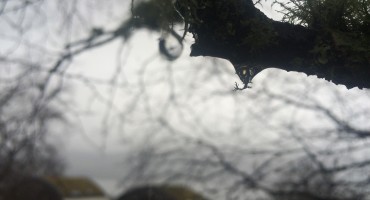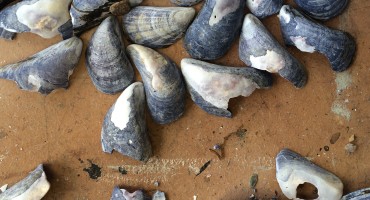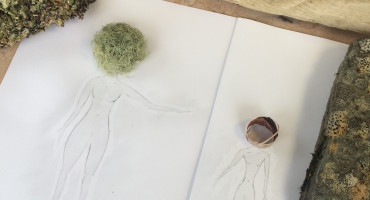The lands and waters of the Netherlands have been constantly shifting throughout its history, by both natural and human forces.
Up towards the North of the Netherlands once sat a large freshwater lake fed by the river IJssel from inland and connected to the North Sea by the river Vlie. On 14 December 1287, a storm tide swept in from the North Sea and battered the natural dunes and clay barriers that delineated this lake from the sea. Becoming inundated with salt water from the North Sea, this lake was transformed into was thence known as the Zuiderzee (Southern Sea). With now an open sea directly next to them trading cities such as Amsterdam rose from nothing into a world power by the mid-17th Century. This change in geography not only altered the socio-political landscape of Medieval Europe, but it left devastation in its wake. This storm killed approximately 50,000 to 80,000 people in the sixth largest flood in recorded history, in the Netherlands and Northern Germany.
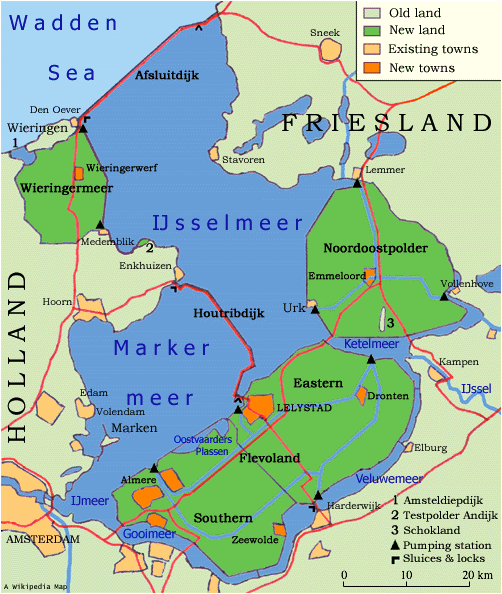
The size of this Southern Sea remained fairly consistent for the remainder of its history with the help of man-made dikes. When volatile storms passed into this body of water there was frequent flooding and loss of ships, such as in the St. Elizabeth’s Flood of 1421, which flooded 72 villages and killed about 10,000 people, due to a seawall in one of the Zuiderzee dike’s being breached. This flooding and volatile weather coming from the Zuiderzee threatened the people and industry in the north of the Netherlands, so a plan to seal off the Zuiderzee from the North Sea was first discussed in 1667. In 1891, Cornelis Lely proposed a retaining dyke which would become the basis for what is known as the Zuiderzee Works (Zuiderzeewerken) and his plans were finally put into effect after devastating floods hit the area in 1916. With the completion of the Afsluitdijk (enclosure dam) in 1932, the Zuiderzee became the IJsselmeer (Lake IJssel). No longer a sea but once again a freshwater lake, fed by the River IJssel. The fishing industry was hardest hit by this alteration of geography, but many went on to work in the construction of the dikes and the reclamation of dry land which was the next goal of the Zuiderzee Works. Over the next 40 years, 1650 sq km of land was reclaimed through the encircling and draining of four polders. The geography of the northern Netherlands was forever altered, allowing not only protection from floods, but vast land for agriculture and housing.
The Zuiderzee Works was not the only project of this size the Dutch tackled in their fight against the sea. After the Flood of 1953 (de Watersnoodramp)—which devastated the South, especially Zeeland—the Dutch realised that even after centuries of engineering they were still not safe from the Sea. To protect the South of the country, they began what is known as the Delta Works (Deltawerken). This project was unique as it was not only concerned with engineering immediate protection, but was looking towards maintaining safety from the sea in the future.
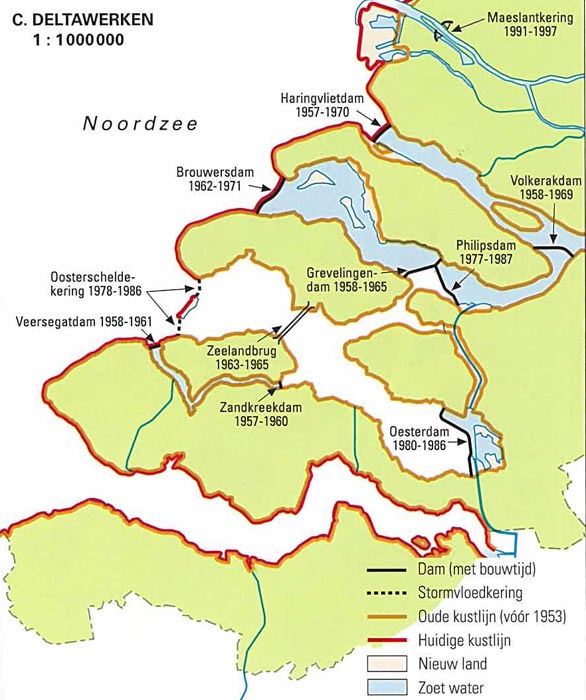 The Delta Works consist of storm surge barriers, dams, locks, levees and dikes, all designed to enlarge the land, shorten the coastline. Thirteen barriers & dams were constructed, totalling over 16,500km, among these are engineering marvels, such as the surge barrier at Oosterschelde, and Maeslantkering, a robotic storm surge barrier protecting the port of Rotterdam. While work was declared finished in 1997, the commission have already begun improvements on the dikes to account for the changing climate and forecast sea-level rise in the near future.
The Delta Works consist of storm surge barriers, dams, locks, levees and dikes, all designed to enlarge the land, shorten the coastline. Thirteen barriers & dams were constructed, totalling over 16,500km, among these are engineering marvels, such as the surge barrier at Oosterschelde, and Maeslantkering, a robotic storm surge barrier protecting the port of Rotterdam. While work was declared finished in 1997, the commission have already begun improvements on the dikes to account for the changing climate and forecast sea-level rise in the near future.
Combined, the Zuiderzee Works and Delta Works are one of the seven wonders of the modern world.
It is incredible the way that the Dutch have engineered their survival in lands which are not immediately hospitable to human survival. The risk of devastation from flooding is constant, though now mitigated by the work they have done to secure their coastline and internal flood defences. It does make me ponder the role of humanity in nature. Humans have always tried to survive in climates which are not suitable. Over the years we have engineered ways to adapt, whether that be making clothes of the skins of animals native to that habitat to constructing boats to travel across water inaccessible by foot. We have always been adapting and we have always left our footprint behind. It would be easy to condemn the Zuiderzee Works on an ecological basis, as humans altered what was a saltwater ecosystem and reclaimed land that would have belonged to wet flora and fauna, though this are was once a freshwater lake—so perhaps it is natural for things to shift over time.
In the Delta Works, this fear of altering the ecosystem came up, as the first plan was to completely close off the Oosterschelde, which would have transformed the saltwater estuary into a freshwater lake. Environmentalists and Fishermen fought against the governments plans as this would not only disrupt the livelihood of the Fisherman in this estuary, but would also have drastic effects on the ecosystem. The government did decide to change their plans and to construct a surge barrier which would only close when the tide was forecast to be too high, allowing for the ecosystem to survive as at present.
The Dutch are not the only country who have played ‘God’ in the alteration of land and ecosystems, it can be seen all over the world. Man-made islands are continually being created in the Middle East and East Asia—if this changes the ecosystem in these regions, I am not sure. What I find interesting in it all is the fear that is present when Nature ‘attacks’ and overwhelms our man-made structures. It is perhaps a fear which comes from a knowing that we have altered or that we are in a place where we humans are not meant to be. We are continually aware of our human fragility when encountering the terrifying sublimity of the natural world. While we build up more and more defences against the shifting climate and the forecast sea-level rises, is there a part of us which knows that sea could at any moment reclaim what is hers?

